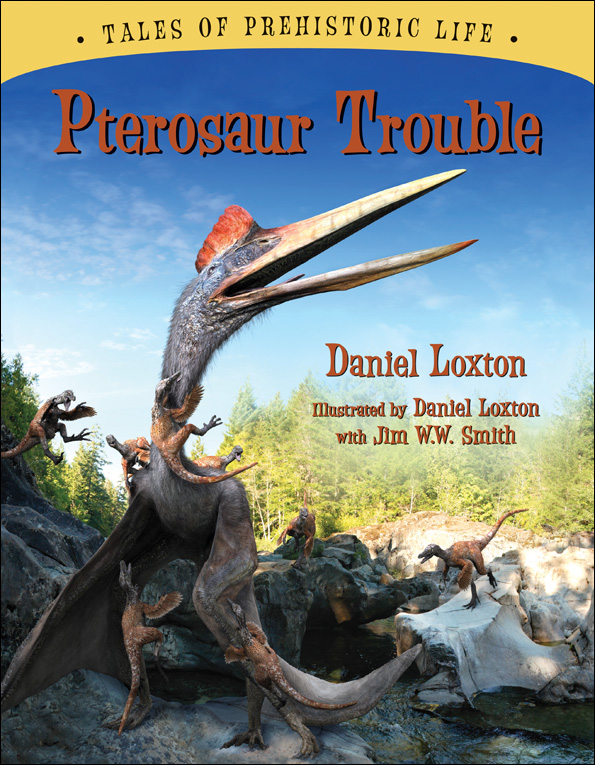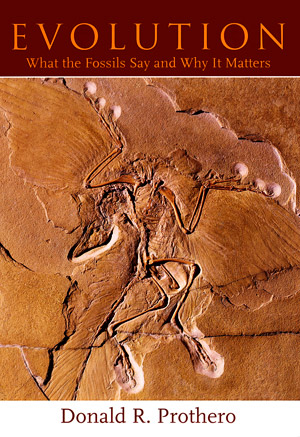by
Donald Prothero, Jul 03 2013
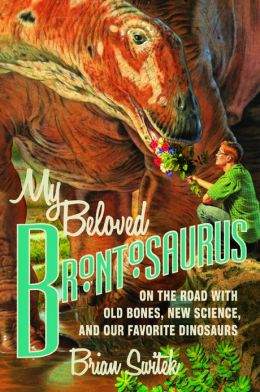
A Review of My Beloved Brontosaurus: On the Road with Old Bones, New Science, and Our Favorite Dinosaurs
by Brian Switek
(Scientific American/Farrar Straus Giroux, New York, 256 pp., 2013)
The dino-bug is now pervasive in American culture, so that kids between the ages of 4 and 12 are nearly all bitten by it. Most kids can name dozens of those tongue-twisting dinosaur names, and are full of all sorts of dino-trivia and tidbits. Dino-mania is a huge business, with millions of dollars being made in marketing books, toys, geegaws, and all sorts of dino-paraphernalia (none of that money, by the way, goes to support paleontology or dinosaur research). It was not always so: when I grew up in the 1950s, there was very little interest in dinosaurs, very few decent books or toys, and I was considered a freak in my elementary school because I knew so much about prehistoric life.
However, when those hormones kick in and the teen years begin, most kids lose their interest in dinosaurs or science, and move to interests in the opposite sex, along with being cool and hip to the trappings of teen culture. Some, like myself and most vertebrate paleontologists I know, never outgrow our love of dinosaurs, and were determined to become paleontologists. Most did not survive the brutal job market, where fewer than 20% of the Ph.D.s in paleontology get any kind of job remotely related to their training (mostly teaching in small colleges, or in medical school anatomy posts). Very few get to occupy the prime positions in the major museums and top universities (there are no more than 50 such jobs in the entire United States, and they are vanishing). Continue reading…
comments (3)
by
Donald Prothero, Apr 10 2013
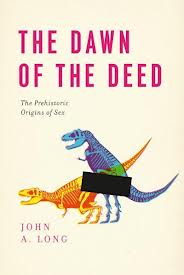
A review of The Dawn of the Deed: The Prehistoric Origins of Sex, by John A. Long (University of Chicago Press, Chicago, 2012).
As I mentioned in last week’s post, we all know that subjects like sex and dinosaurs are guaranteed to get the public’s attention and interest, no matter what story you want to promote. Paleontologist and author Dr. John A. Long (formerly the Vice-President of Research and Collections at the Natural History Museum of Los Angeles County, but now back home in Australia as the Strategic Professor in Palaeontology at Flinders University in Adelaide) has cleverly woven a story about the wild sex lives of the animals kingdom as a hook to talk about his own research into the fossil fish (especially an extinct group called placoderms), which show the first evidence of internal fertilization, the oldest known vertebrate embryos, and the first copulatory structures.
One would think that a story about small extinct placoderms in nodules from the deserts of Western Australia would be a hard sell for a popular book, but Long pulls off the feat with aplomb. The heart of the book is filled with Long’s excitement about this research as he finds and uncovers these amazingly 3D fish fossils from the nodules of the Gogo beds, then compares them with fossils described from collections elsewhere in the world. He soon discovers that mysterious structures that were misidentified or ignored by previous fish paleontologists are actually pelvic claspers (long rodlike structures also found in the pelvic fins of modern sharks to aid them in copulation with females). Then he and his colleagues discover traces of tiny bones inside an adult placoderm that were misidentified as their last meal, but turn out to be embryos. We follow Long’s story as he works on this research until is it is accepted to be published in top journals like Nature. The discovery gets global coverage, and Long even takes part in big media events with a live uplink between the announcement in Australia and Queen Elizabeth of England (in a chapter called “Announcing Fossil Sex to the Queen”). Continue reading…
comments (2)
by
Daniel Loxton, Mar 20 2013
Hi, folks! I’m excited to announce that my brand new children’s paleofiction storybook Pterosaur Trouble is hitting stores, with both Amazon.com and Amazon.ca now listing it as “in stock.” (The official release date is April 1st. Other vendors, including my own home-team headquarters on the web, the Skeptics Society’s Skeptic.com, will have it in stock in the coming weeks.) Continue reading…
comments (4)
by
Donald Prothero, Jan 30 2013
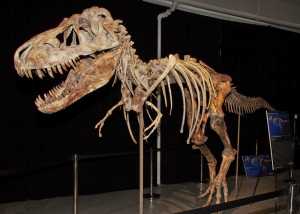
The tarbosaur specimen poached and smuggled from Mongolia by Prokopi and his partners, and almost sold at auction back in May.
Back on May 23, I posted about the story of a skeleton of the Mongolian tyrannosaur Tarbosaurus that was about to go up for auction. The specimen was a nearly complete skeleton, mislabeled “Tyrannosaurus” to increase its market value, and a major auction house was served with a restraining order just after it had auctioned off the specimen for over a million dollars. The paleontological community had been in an uproar for weeks when the sale was first announced, since it was clearly a smuggled and illegally poached specimen from Mongolia, where no fossil can be removed for sale legally. The Mongolian government, U.S. Customs and Homeland Security, and many others were investigating the specimen. Both American and Mongolian paleontologists pointed out that this species is only known from Mongolia, and furthermore, the matrix around the specimen and its distinctive bone texture and color demonstrated it came from the Nemegt Formation, the only Mongolian formation where tarbosaurs have been found.
Shortly after the story appeared, the sale was stopped pending further investigation. Then the wheels of justice began grinding slowly along as investigators dug into the data about the fossil, tracked down the anonymous “paleontologist” who had procured it, and then supplied the information to our legal system. Just before New Year’s Eve, the story broke that the culprit, poacher Eric Prokopi of Gainesville, Florida, had pled guilty. His sentencing is due in May, and he may get up to 17 years in prison for smuggling contraband into the U.S. Continue reading…
comments (11)
by
Daniel Loxton, Oct 15 2012
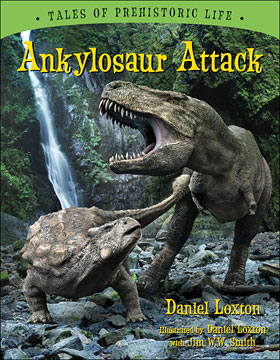
Click for Ankylosaur Attack listing at Shop Skeptic
I’m very excited to announce that Ankylosaur Attack, my first paleofiction storybook for young children (illustrated with Jim W.W. Smith) is among the 2013 Forest of Reading® Silver Birch® Express Award nominees revealed this morning by the Ontario Library Association. This will make the book part of Ontario’s province-wide school and library reading program—the largest such program in Canada.
I’d like to express my immense gratitude to the Ontario Library Association for this nomination (and of course to my publisher, Kids Can Press). The Forest of Reading awards are exceptionally competitive in every category, and it’s an honor to be in such fine company. (My nonfiction Evolution: How We and All Living Things Came to Be was nominated for the Silver Birch nonfiction award, which went that year to my friend Valerie Wyatt—Editor of both Evolution and Ankylosaur Attack, and veteran of over a hundred other children’s books).
Continue reading…
comments (5)
by
Daniel Loxton, Sep 18 2012
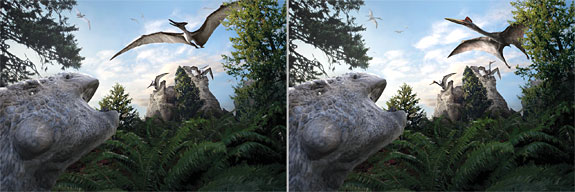
Original and revised version of Ankylosaur Attack spread. Click to enlarge and compare. (Popup gallery window will display the original version first. Click “next” on the right side of the popup image to see the revised version. Click “prev” on the left side of the image to jump back to the original version.)
At this point in my life I can claim a few trades. I don’t think it’s an exaggeration to say I have a reasonable amount of professional experience in sheep herding, in illustration, in writing for kids, or in critical scholarship regarding paranormal claims (or at least certain such claims in specific). But there are many things I’m not—things with which skeptics may sometimes feel more identification than we have expertise. I’m not a psychologist, sociologist, nor doctor, for example. My statements related to those (and indeed most) academic fields should not be considered remotely authoritative.
And despite my children’s books touching on topics of prehistoric life, I’m not a paleontologist.
I care about accuracy in all my work. But although I work hard to get things right in my natural history-informed paleofiction storybooks for kids (Tales of Prehistoric Life, from Kids Can Press), it was probably just a matter of time until some error came to light. That happened when we brought in paleozoologist (and Scientific American blogger) Darren Naish as Science Consultant early in the production cycle for Pterosaur Trouble (the upcoming second book in the series, following Ankylosaur Attack).
Continue reading…
comments (10)
by
Donald Prothero, May 23 2012
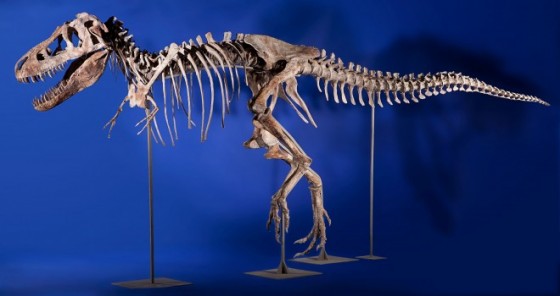
The Mongolian tyrannosaur specimen that was to be auctioned off on May 20.
The buzz was going back and forth among my paleontologist colleagues for weeks: an important tyrannosaur skeleton (Tarbosaurus bataar) that had been poached from Mongolia was scheduled to auctioned off on May 20 in New York City. We paleontologists were all outraged, and spent days signing online petitions, blogging, and sending letters and emails to the appropriate parties, but the tiny scientific community of vertebrate paleontologists in the U.S. (no more than 2000 people) don’t hold any real positions of power beyond a handful of museum curator positions and top professorships. But our activity got the attention of the Mongolian government, and they sent formal letters of protest to the auction house and the American government. All the emails and blog posts were full of anger and despair that such blatant theft could be rewarded with a million-dollar sale. Then, just hours before the auction was to start, a Texas judge issued a Temporary Restraining Order, and it appeared that the the fate of the Mongolian tyrannosaur was put on hold. But the auction house went ahead with the sale anyway, getting a final bid over over $1 million, and arguing that the Texas judge has no jurisdiction over a New York auction house. This occurred, even as the attorney for the Mongolian government was in the auction room with the Texas judge on his cell phone, trying to make himself heard and to get anyone to listen to the judge. The sale went on pending resolution of legal issues, so now it is in limbo for a while until this could be sorted out.
This story highlights a much bigger problem that most people never hear about: the huge international market in stolen fossils and antiquities. Bit by bit, some governments are becoming better at protecting their national treasures, but the poachers and smugglers are always much better funded and quicker than even Interpol. Not only is there a big black-market trade in stolen artwork and artifacts, but the market in natural objects is equally brazen and profitable. The stories I’ve heard just want to make you cry! Now that all five species of rhinoceros are nearly extinct in the wild, mounted rhino heads in older natural history museums all over Europe have been stolen or defaced just for their valuable rhinoceros horn (worth more than cocaine or gold by the ounce, all because “traditional Chinese medicine” believe rhino horn reduces fever). Famous fossil localities in protected national parks all over the world are brazenly poached by thieves, destroying not only most of the fossils but ruining the locality for its scientific value as well. Museum research collections and even specimens on public display with security guards and video cameras protecting them are stolen or damaged by thieves. One-of-a-kind fossils that are certainly new species and genera and have the potential to revolutionize our understanding of life’s history are seen briefly and then end up on some rich person’s living room. (Lately, one of the biggest problems is the fad among rich Hollywood celebrities like Nicholas Cage and Leonardo di Caprio to have their own dinosaur in their living room). Even above-board organizations like some major auction houses and the more reputable fossil dealers have to be careful of poached specimens with fraudulent locality data hiding the illegality of their collection. I’ve heard the horror stories from my colleagues who had the proper permits and found an important bone bed on Federal land, only to come back a few days later and someone had plundered the best material and left the rest in broken piles, hacked out of the ground with no attempt to protect the fossil in a jacket—or record the location and stratigraphic horizon of the specimen, which is a big part of its scientific value. It’s common practice now to bury your excavation and hide it once you leave so this doesn’t happen, and I’ve had museums ask me to not publish my GPS coordinates of paleomagnetic sites that also might give away locations of fossil localities. My paleontologist friends in the fossil-rich National Parks are constantly having to spend more and more time planning on how to prevent poaching, and less time doing the science they are better qualified to do. The situation on private land is even messier: although it is usually legal to collect on most privately-held ranches with the consent of the landowner, the story of the tyrannosaur named “Sue” showed that handshake agreements, and disputes over where the specimen was found, and unclear property rights can make those specimens a legal nightmare. Continue reading…
comments (11)
by
Donald Prothero, Apr 25 2012
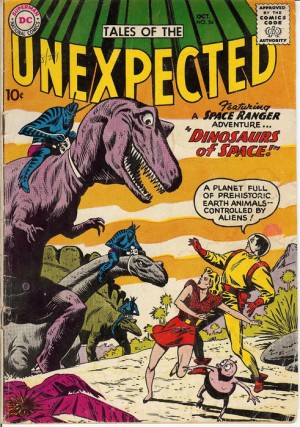
As someone who has frequently had his scientific research featured in the popular media, I’m painfully aware of the constant struggle between conveying science accurately and trying to make it sexy and newsworthy. Scientists are perpetually frustrated because reporters are often scientifically illiterate, and reduce the story to a level they can understand—which totally misrepresents what the science is about. The science reporters I know are equally frustrated at scientists who don’t know how to communicate the essence of what they are doing, or who are aloof and uninterested in making the public more aware of the reasons why their tax dollars should support pure scientific research. I’ve had my work oversimplified or misrepresented many times, and I’ve seen the work of others completely butchered by incompetent science reporters. I’ve also seen scientists who make outrageous claims and trust gullible science reporters to buy it, hook, line and sinker—and this happens FAR too often (see my April 4 post about the coverage of a ridiculous claim by an amateur that dinosaurs were aquatic, or my Nov.2 post about gigantic Triassic squids arranging ichthyosaur bones).
One of the problems both scientists and reporters face is how to make the research sound interesting to a lay public that knows almost nothing about science—and much of what the public thinks they know is wrong. Much of chemistry and physics is incomprehensible and uninteresting to people that never took a single class in high school on physics or chemistry, and even something more immediate like biology is full of subjects that are obscure to the lay audience. Geologists usually have it slightly better, since topics like earthquakes, volcanoes, landslides, climate change, etc., are easier to relate to.
We paleontologists usually have it even easier, because a few of us work on something immensely popular—dinosaurs—although I’m really a Cenozoic fossil mammal specialist and only rarely has my research ventured back to the Mesozoic. Just add dinosaurs and the research goes to the front page of most science news websites or The New York Times, or gets published in high-profile journals like Nature, Science, or PNAS. But when I make an important discovery on a group such as rhinos or peccaries or camels, I’m lucky to get it published in a third-tier journal, and I typically get no reporters calling at all. The Cretaceous-Tertiary extinctions that wiped out the non-avian dinosaurs generated huge interest when the asteroid impact theory first emerged in 1980, with thousands of papers published and dozens of books on the topic. But it’s only the third or fourth largest extinction in earth history. The great Permian extinction 250 m.y. ago, which wiped out 95% of species on earth, is lucky to get ANY press attention. Who cares about productid brachiopods, or fusulinids, or tabulate or rugose corals, among the many victims of this event? Continue reading…
comments (20)
by
Donald Prothero, Apr 04 2012

The long-discredited idea of sauropods snorkeling in deep water as illustrated in this old painting by Zdenek Burian. The biggest problem is that they couldn't breathe in water this deep with the pressure it puts on their lungs.
The story popped into my email box earlier this week and soon I had dozens of follow-up emails from the vertebrate paleontology listserver flooding my inbox. Once again, the media have shown their complete inability to get the science right and publicized another flashy story that was complete garbage. I already gave an example last fall (my Nov. 2 post) with Mark McMenamin’s ridiculous claim that a giant Triassic “kraken” rearranged the bones of ichthyosaurs to create art. (By the way, that claim has dropped out of sight, and I don’t ever expect to see it published). As soon as the furor of that media gaffe dies out, however, they commit an even bigger blunder.
This time it was an article in the British media, starting with a “journalist” Tom Feilden (previously caught plagiarizing dino stories) reporting for the Telegraph doing an interview that then got coverage on both BBC radio and TV and on their website. In the brief story, a “Professor” Brian J. Ford makes the claim that giant sauropod dinosaurs were aquatic, not land-dwelling creatures. Immediately, the first reaction that my paleontologist colleagues and I had was “Who the hell is ‘Prof. Brian J. Ford’?” and “Did he say this in 1900?” To us, the article was startling not because it has some new insight on sauropods—but because someone who clearly had no idea about the last century of sauropod research had managed to get all this publicity, and there was no evidence he had any credentials to be taken seriously!
Continue reading…
comments (20)
by
Donald Prothero, Dec 14 2011
I have written frequently in these blogposts about the numerous forms of denial of science and reality that are out there, from global warming denialism, to AIDS denialism, anti-vaxxers, and creationism. They all have a lot in common, from their insular exclusionary attitude that refuses to accept evidence that doesn’t fit their world view, to the various strategies they use to reduce cognitive dissonance and fight against reality, all borrowed from the Holocaust deniers. These include: quoting out of context (“quote-mining”) to dishonestly suggest that the quoted person agrees with them, cherry-picking data to show the exact opposite of what the data really show, making phony lists of “experts” who agree with them, picking on the small differences within the scientific community as evidence that the “science is not settled”, picking on one small factoid (usually misinterpreted and out of context) as evidence that the whole of science is false, and so on. Usually, these obvious strategies to deny an overwhelming body of evidence are so transparently self-delusional that we can laugh at them.
 But then I ran into something that staggered even my sense of how low these people can go. We are all familiar with how creationists use ad hoc explanations and special pleading to rescue the absurdities of their world view, from trying to cram all of the animals into Noah’s ark and dismissing the huge numbers problem through their non-biological concept of “created kinds”, to doing all sorts of violence to the geologic record to justify the Noah’s flood story, to even insisting that men have one less rib than do women (the last one is easy to check, but they don’t). As I have discussed in several previous posts, the more extreme Biblical literalists also believe in a flat earth and reject the heliocentric solar system. But I was flabbergasted to read of a whole group of extreme creationists who deny that dinosaurs existed! Usually, the creationists not only come to terms with the evidence of dinosaurs, but many have even tried to co-opt their popularity with kids under 10 by making them a prominent part of their propaganda (as does Ken Ham of the “Answers in Genesis” ministry and the “Creation Museum” in Petersburg, Kentucky). With something as widely accepted and exciting and popular as dinosaurs, which anyone can see for themselves in their local museum, how could any person in the 21st century argue they are not real?
But then I ran into something that staggered even my sense of how low these people can go. We are all familiar with how creationists use ad hoc explanations and special pleading to rescue the absurdities of their world view, from trying to cram all of the animals into Noah’s ark and dismissing the huge numbers problem through their non-biological concept of “created kinds”, to doing all sorts of violence to the geologic record to justify the Noah’s flood story, to even insisting that men have one less rib than do women (the last one is easy to check, but they don’t). As I have discussed in several previous posts, the more extreme Biblical literalists also believe in a flat earth and reject the heliocentric solar system. But I was flabbergasted to read of a whole group of extreme creationists who deny that dinosaurs existed! Usually, the creationists not only come to terms with the evidence of dinosaurs, but many have even tried to co-opt their popularity with kids under 10 by making them a prominent part of their propaganda (as does Ken Ham of the “Answers in Genesis” ministry and the “Creation Museum” in Petersburg, Kentucky). With something as widely accepted and exciting and popular as dinosaurs, which anyone can see for themselves in their local museum, how could any person in the 21st century argue they are not real?
Continue reading…
comments (56)



